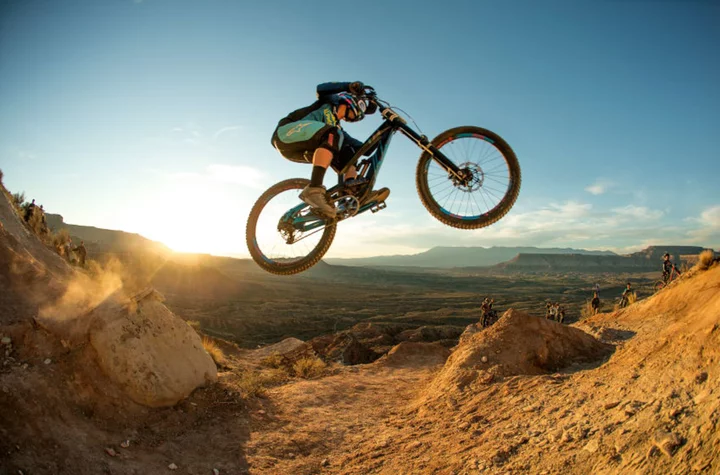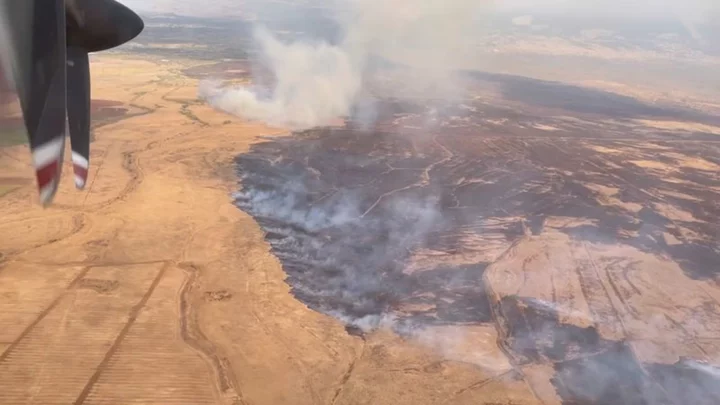"Everybody dies, but not everyone truly lives." Those were the words said to me by freeride mountain biking legend Brett Tippie following this year's Red Bull Rampage event in the sandy deserts of southern Utah.
In many ways, those words epitomize what it means to be a freeride mountain biker. You live every day to the fullest. You accept the dangerous realities of your sport because it's how you feel fulfilled in life. This is your dream — your passion. It's what keeps you up at night and what allows you to keep moving forward during the day. This is how you live.
Tippie may be one of the pioneers of this sport, but that mindset is shared by the thousands of freeride mountain bikers who have followed in his footsteps. Those footsteps have taken a select few to the so-called "Super Bowl of mountain biking" directly outside of Zion National Park in Utah.
Red Bull Rampage made its debut all the way back in 2001. It was the first large-scale freeride mountain biking event of its kind, although the 2001 iteration of the event pales in comparison to what it would look like some 22 years later.
The first edition of the tournament was very much a grassroots effort. It was the wild west of mountain biking. Fast forward two decades, and you have helicopter camera shots, drones flying above the course, thousands of fans in attendance, and millions more watching at home. The 2023 Red Bull Rampage was the largest and most impressive in the event's illustrious history, and I was fortunate enough to be in attendance this past October.
But what is Red Bull Rampage? How does this event work? What differentiates it from other mountain biking events? What are the rules, and what motivates these competitors to participate? Those were the questions I set out to answer that weekend in Utah. I came away with a newfound respect and admiration for the athletes who call this sport their home. It's an event like no other in the sporting world. Nothing compares to Red Bull Rampage.
Unlike other biking events, Red Bull Rampage is not a race. The objective is simple — get down the mountain in the coolest way possible. Riders are judged on a series of four criteria: difficulty of line, air amplitude, control and fluidity, and tricks and style. Each competitor is given two attempts at their run, and the rider with the highest score at the end of both runs is the winner.
What differentiates Red Bull Rampage from other events, however, is that there is no set course. Riders build their own line. Competitors arrive at the site of the event 10 days before it begins. Each competitor brings with them a team of two diggers who will help them create and shape their line for the tournament. The riders themselves are also tasked with building their line. After all, three sets of hands are better than two, and there is serious time pressure to complete your line.
In the past, teams were only permitted to use their hands and feet to shape lines, but the event now allows the use of sandbags (each team is given 75) and water. The goal is to keep the terrain as natural as possible while still allowing for increased creativity. Riders are allowed to start practicing on their line over the final four days before the event, although it's not uncommon for a rider to go into the event without having fully completed their run in practice. It's a grind — one that these competitors have become accustomed to.
Take Darren Berrecloth, for example. Berrecloth has competed at Red Bull Rampage a whopping seven times, and while he wasn't participating in this year's event, he was still able to offer some insight into what it's like competing on the grandest stage of mountain biking.
"It's the worst feeling in the world going to sleep without being able to hit all of your features," Berrecloth explained.
Preparing for an event like this is all about confidence and preparation. It's no different than any sport in that regard. The more you prepare and practice, the more confident you will be in your own abilities and the more likely you will be to succeed. The only difference is that the consequences for failure in this event could mean serious injury…or even worse.
Berrecloth explained how virtually every rider he knows has a laundry list of broken bones and other injuries they've suffered throughout their careers. Skull fractures, broken necks, broken limbs, concussions, etc. are all par for the course when it comes to freeride mountain bikers. This is the life they chose — and they wouldn't have it any other way.
One of the 18 planned participants for this year's Red Bull Rampage event, Gee Atherton, helped remind everyone of the dangers of this sport. Atherton was scheduled to compete at Rampage for the first time since 2010, but during a practice run prior to the event, he suffered a horrific fall that landed him in the hospital with serious injuries.
Atherton sustained multiple fractures to his vertebrae and skull and was unfortunately forced to miss the event. One would think that those injuries would render Atherton bedridden for weeks (if not months), but the British-born biker was seen on his feet mingling at the afterparty less than a week after his fall. Injuries are just a part of their lifestyle.
For Berrecloth, his exposure to mountain biking came at a young age. He grew up in the mountains of British Columbia, Canada, and always wished he could ride down them one day. When asked what his motivation for choosing this career path was, his answer was simple but nonetheless profound.
"I just wanted to do rad s—t."
It's straightforward, sure, but it's also that very mindset that drives many of his fellow competitors to do the same. They ride to feel alive.
For an event like this, mental preparation is just as important as physical preparation. You need to be confident in your own abilities. You need to feel comfortable on your bike at all times. You need to be in the right state of mind.
Take it from 2023 Red Bull Rampage runner-up, Tom van Steenbergen. van Steenbergen's journey back to the top of freeride mountain biking has been a long and arduous one. After placing third in the 2019 event, van Steenbergen returned in 2021 looking to secure another podium finish.
Instead, the Canadian-born biker suffered a gruesome crash that shattered his hips and left him unable to walk for three months. He miraculously returned to the same event less than a year later and was able to complete his run. Another year later, van Steenbergen finished in second place at Rampage. His recovery process is still ongoing.
"It was really tough," van Steenbergen told me when asked about his road to recovery. "I'm still recovering. I still have pain from that crash. It's really tough mentally, but physically, it was obviously tough as well. It's a never-ending process of trying to stay healthy and regain your confidence."
The road to recovery is a challenging one for any athlete, and that's especially true for these competitors. It takes years of practice and preparation before anyone can feel even semi-comfortable scaling these mountains and riding down them.
You need to be completely in control of your mind and body. You have to have full trust in your digging team and your own building abilities. And, of course, you need to believe you can accomplish your overall goal. It sounds cliche and overly sentimental, but it's 100 percent true. Any doubt in your own abilities could lead to a disastrous outcome.
"You have to believe in yourself," van Steenbergen explains. "As much as it sucks, you have to know that the consequences are severe. You can crash really hard, and you have to make sure your body is ready for that."
Perhaps the most challenging aspect of a rider's run comes just before they begin. Riders are given eight minutes to wait atop the mountain before their run is nullified. This typically gives competitors ample time to let the wind die down so that they can complete their run in the best conditions possible. It also allows plenty of time for contemplation. Sometimes, thinking can be a rider's worst enemy.
The point of no return is discussed quite a bit in freeride mountain biking circles. It's the moment you begin your run. After that, there is no stopping. There's no turning back. The only way down is through the line you spent almost two weeks carefully and meticulously crafting.
The anticipation and nerves going through the minds of riders at that point are indescribable. Some find a way to completely clear their mind before their run. Others use their fear and anxiety as motivating factors.
"It's a different situation for every rider," Berrecloth insisted. "Some athletes utilize the fear to work in their favor. Other riders can just turn that switch off."
Berrecloth went on to describe how some riders struggle to handle the pressure. He told stories about his fellow competitors puking the night before the event or even moments before their run. "Some guys just hate competing," he says.
Whether a rider is nervous or calm, everything changes once their run begins. The adrenaline takes over. You become entrenched in a focused mindset. For the next two minutes, the rest of the world doesn't exist. It's just you, your bike, and your line.
"Once you drop in, you get into a flow state," Berrecloth explained. "Whether you're scared s—tless or just excited, you become focused on the task at hand."
It's the contrived creativity that helps distinguish Red Bull Rampage from other mountain biking tournaments. There isn't another event in the sporting world that requires participants to build their own course out of natural features and complete said course, all while attempting dare-devilish feats of human achievement.
It's not about speed — it's about surviving in style.
2023 Red Bull Rampage winner Cameron Zink believes that innovation is what makes this event so special. Zink is one of the most accomplished athletes in Rampage history. He became only the fifth rider to win the event twice when he emerged victorious this October. For Zink, the cooperative nature of Rampage is what helps it stand out.
"I think the camaraderie is what makes it so special," Zink explained to me after his historic win. "That's just one of the many things that makes Rampage so special."
Zink praised his digging team for their efforts, calling diggers the "unsung heroes" of Rampage. He explained how riders should have a good rapport with their diggers and that they must trust them intrinsically. It's a collaborative effort. While the riders are the ones who receive the most attention, it's really a team sport. That's partially what makes Rampage so unique.
The other aspect is the aforementioned creativity. This often-overlooked facet of the sport is just as important, and arguably even more challenging, than the actual ride itself. Teams are tasked with creating a line out of the natural landscape. The mountains are their canvas. They are the painters. At least, that's how Berrecloth described the process to me.
"We take this as an open canvas and paint our dreams," he says. "The line, itself, is like how a painter paints his own canvas."
van Steenbergen has a different perspective on the process. He explains how his brain is wired to view potential lines in the landscape wherever he goes. He sees various rock formations as features in a possible line. He sees sandy inclines as potential ramps. His brain has been trained to visualize different elements of a line in his surrounding landscape.
He's not just a rider — he's an artist. He's a sculptor. This is his craft.
I was fortunate enough to be given the opportunity to visit the mountain site prior to the event — We didn't climb to the very top, but we got far enough up to truly appreciate the scale of the operation.
The air was dry. The terrain was rocky. There was sand all over our clothes. Looking down on a sea of workers, media members, on-site officials, and other personnel in attendance before the event, we were able to witness firsthand just how daunting this experience can be. It's not for the faint of heart. Heck, even the most daring and fearless athletes in the world suffer from severe anxiety at the thought of even participating in such an event.
But that's part of the appeal, though, isn't it? This isn't for the 9-to-5 workers out there. This isn't some side hobby for your everyday average Joe. This is a lifestyle. It's the fate they've chosen because these guys want to experience life to the fullest. They're aware of the dangers. They understand the consequences. If anything, that just makes it more enticing.
Rampage has become the pinnacle of progression in freeride mountain biking. Participants in this event seek to push the limits of what the human body and mind are capable of.
And then, when the dust literally and figuratively settles, they return the landscape to its natural state. They leave no trace behind. They came, they rode, and then they left. That's the Rampage cycle — it's one these riders are proud of.
We, as humans, should all seek a passion in life that helps us truly feel alive. For some, that's a stable office job, a home with a family, and whatever else ticks those boxes.
For others, this is what does it. "Everybody dies, but not everyone truly lives." At the end of the day, there's no denying that these individuals have truly lived.









